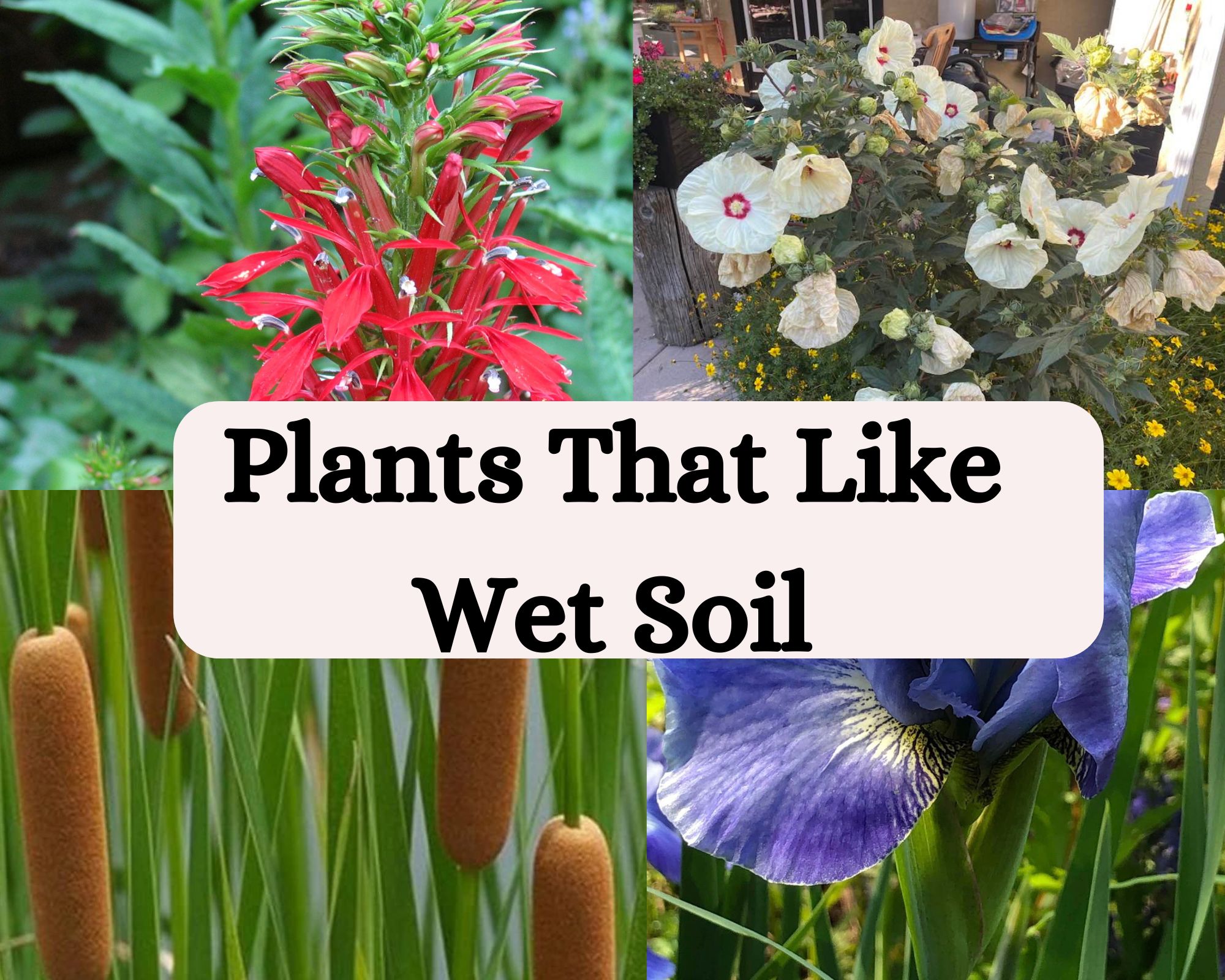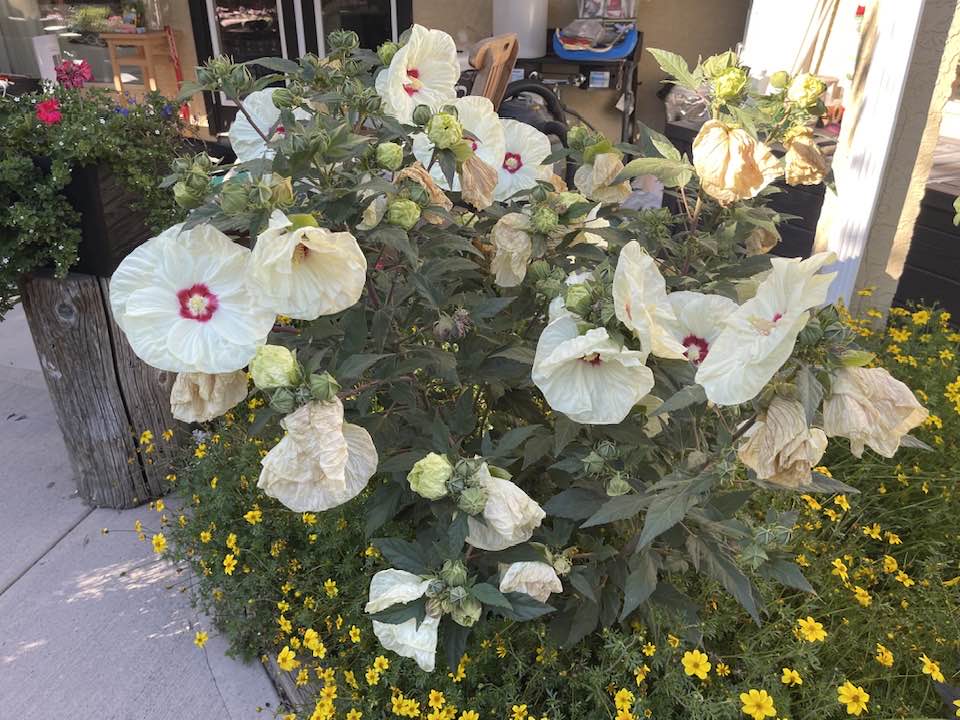Do you have soggy spots in your garden or live in a wet climate? Introducing vegetation to these places can be tricky, especially since most plants shun overly wet conditions, often preferring to keep their feet drier. However, some plants revel in damp soil, thriving in boggy areas.
Embrace and take advantage of plants that love having their feet wet, and you won’t have to leave the area bare or spend your precious hours and resources changing the wet soil. Besides elevating your garden’s aesthetics, wet soil-loving plants can solve erosion, runoff, and drainage issues.
Below are 20 plants that like wet soil to aid your selection.
20 Plants That Like Wet Soil
1. Cardinal Flower
Cardinal flower is a beautiful perennial that hummingbirds cannot resist naturally grows in wet, marshy environments such as stream banks, wet prairies, pond edges, and rain gardens. It prefers damp, rich, humus-filled soil. In addition, it flourishes in partial sunlight but also performs well in full sunlight.
To keep your cardinal flower healthy, keep the soil wet, especially when dry, by applying organic mulch. It grows to 1-6 feet tall.
Hardiness zones: 3-9
2. Japanese Iris
The perfect environment to grow Japanese iris is one with wet, rich, acidic soil and receives full sunlight or partial shade. Make sure the soil doesn’t get dry, particularly during the growing season. Japanese iris loves its roots in shallow water.
Plant Japanese iris in your rain garden, along the edges of your water features, or in borders that receive ample water.
Hardiness zones: 4-6
Note
Siberian iris also likes wet soil.
Read More:
3. Hardy Hibiscus
Give your garden a dramatic, tropical look all summer long with hardy hibiscus’s pink, white, or red dinner-plate-size flowers. This show-stopping plant loves wet soil but adapts to soils.
Hardy hibiscus is perfect for consistently damp areas like pond edges. Hardy Hibiscus is surprisingly cold-hardy. It can survive winter, withstanding temperatures as low as -30°F.
Hardiness zones: 4-9
4. Marsh Marigold
While marsh marigolds don’t like being submerged, they depend on constant moisture to thrive. Marsh marigolds produce yellow, buttercup-like flowers and glossy, round leaves, so grow them in your garden’s wet spots for a burst of color.
Marsh marigolds are commonly found in partial to complete shade. As an early bloomer, this plant attracts early pollinators. Its foliage also gives small amphibians cover.
Hardiness zones: 3-7
5. Daylily
Daylily will help you control erosion on water banks or steep hillsides because it develops a deep root system. Established daylilies are drought-tolerant, but these hardy perennials are surprisingly adaptable, thriving in different conditions, including consistently moist or wet soil.
Daylilies flower best in full sun, producing many brilliant yellow, cream, or orange flowers, but they also do well in partial shade.
Hardiness zones: 4-9
6. Canna
This tropical plant loves damp soil but doesn’t do well in wet conditions, so avoid planting it in flood zones or low-lying areas. Use canna to give your garden some colorful, tropical flair as this plant has bright red, pink, orange, or yellow flowers and green, huge leaves.
Cannas love heat and do best in 75-degree temperatures or higher. You can lift and store this plant’s rhizomes over winter for replanting in spring.
Hardiness zones: 8-10
7. Forget-Me-Not
Forget-me-not is a short-lived, low-maintenance plant could be the perfect solution for your garden’s wet, bare patches. Once you introduce forget-me-not to your garden or yard, it will self-seed and gradually spread without getting wildly invasive.
Forget-me-not’s stunning baby blue flowers take over the lanky, long stems in May through December. This plant doesn’t like standing water but loves wet, moist soil and full sunlight or partial shade.
Hardiness zones: 3-8
8. Turtlehead
Mainly found in the United States’ easternmost sides, turtleheads prosper in wet soils along large water bodies, streambanks, and riverbeds. Although they are more successful in full sunlight, they do fine in partial shade.
Turtleheads produce pink or white turtlehead-shaped flowers, hence their name. They grow 2-3 feet tall and spread 3 feet, forming a dense clump over time, but it is not invasive.
Hardiness zones: 4-9
9. Trumpet Creeper
This vigorous, deciduous climbing plant performs so exceptionally in wet soils that it suffocates other plants in its growth path. The trumpet creeper’s lush foliage and bright orange-red (occasionally coral or yellow) trumpet-shaped flowers make it a gorgeous garden plant.
Grow it on hillsides, near ponds, alongside walkways, or use it to cover trellises, walls, fences, or pergolas. However, ensure you can control its growth.
Hardiness zones: 4-10
10. Royal Fern
Royal ferns can grow in shallow, standing water all year long, but keep in mind that deep submersion is not ideal. This majestic fern astonishingly flourishes in wet soil, particularly near water bodies. Therefore, use it to fill barren spaces around your water garden, ponds, or woodland garden.
This plant can grow big, reaching 6ft tall and 3ft wide. Royal ferns are evergreen in warm climates and deciduous in colder ones.
Hardiness zones: 3-10
11. Cattail
To stabilize the soil and manage water in a wetland area, grow this classic aquatic plant with broad, ribbon-like leaves, brown seed heads, and tall, slender stems. Cattails naturally grow in marshes, wetlands, and along streams and ponds.
Cattails need consistently waterlogged or wet soil and can grow in shallow water. You don’t need to mulch cattails because they thrive in wet conditions.
Hardiness zones: 3-10
12. Joe Pye Weed
This towering perennial doesn’t shy away from wet ground, making great filler for bare areas in rain gardens, marshes, and near ponds. Joe Pye weed sprouts stunning large, violet, dome-shaped flowers that can spread to a foot.
As for size, Joe Pye weed can grow to 12 feet. Expect pollinators to take over your garden, as this plant produces lots of nectar.
Hardiness zones: 4-9
13. Spiderwort
Moist soil suits spiderworts best, but this plant also tolerates damp soil and, once established, can handle occasional dry spells. This flowering plant also adapts to various light conditions, from full sunlight and shady areas to partial sun.
Spiderworts adorn colorful flowers and green, arching, strap-like leaves. You can let it grow wildly or contain it in your garden beds.
Hardiness zones: 4-12
14. Swamp Milkweed
With such a name, you know this plant loves water and naturally grows in wet areas. An established swamp milkweed can handle brief periods of drought, but don’t let it dry out entirely.
The leaves of this plant host monarch caterpillars, and the flowers provide pollinators with nectar. Since swamp milkweed grows to 8 feet tall, it dramatically contrasts with lower-growing plants.
Hardiness zones: 3-9
15. Pickerel Weed
This plant is practically born for wet conditions, always seeking the marshiest and wettest spot to inhabit. The wetter the ground, the better for pickerel weed; in fact, it loves its roots submerged.
Although it tolerates partial shade, pickerel weed requires full sunlight. It spreads rapidly, but you can control it by dividing or trimming it.
Hardiness zones: 3-10
16. Buttonbush
Buttonbush feels at home in wet areas, especially those with perpetually moist or even flooded soil. It tolerates standing water, so consider it for your garden’s low-lying areas or along water edges. You can grow it in any soil type, from loam to clay, provided it contains high moisture levels.
This plant is nicknamed “honeyballs” because of its round, white flowers that look like tiny, spiky pincushions.
Hardiness zones: 5-11
17. Horsetail
This plant has been around for millions of years, so if you are looking for a historical plant for wet areas, this is the perfect choice. Horsetail revels in soggy conditions, often growing where water is in plenty.
Instead of traditional leaves, horsetail has hollow, rough, jointed, bamboo-like stems. Horsetails colonize areas quickly by reproducing through spores and sending out underground rhizomes.
Hardiness zones: 4-9
18. Virginia Sweetspire
Native to the United States’ southeastern parts, this plant is prevalent in wetlands, stream banks, and moist woodlands. Virginia Sweetspire looks beautiful in large shrub clusters with oval to oblong, bright green leaves that turn purple and red in fall.
Virginia Sweetspire loves growing in partial shade or full sun.
Hardiness zones: 5-9
19. Sweet Flag
For a grassy, aromatic option, grow Sweet Flag. Crushing this wet-soil plant’s bright, glossy, long, slender, green leaves emits a subtle, sweet fragrance. Aside from the attractive, fragrant foliage, this plant produces small, greenish-yellow spiky flowers to complement the overall aesthetics.
Sweet Flag isn’t just pretty but also robust, low-maintenance, and adaptable.
Hardiness zones: 4-10
20. Ligularia
Last on the list is ligularia—a striking perennial with a commanding presence perfectly suited for wet conditions. This plant is happiest when its roots are moist and cool.
Ligularia is undeniably beautiful when it blooms, sending up tall, bright, yellow, or orange daisy-like flower spikes or clusters. Plant ligularias in places that get morning sun but are shaded during the day’s hottest hours.
Hardiness zones: 3-9
Final Remarks
Soggy gardens deserve love, too, and the wet soil-loving plants will help you showcase that. Above are excellent choices that make great fillers to help you turn your garden’s soggy patches into stunning, thriving spaces. Let them help you bring life to the naturally boggy areas, a garden bed that retains moisture, and spots prone to flooding.

Hey there, fellow plant enthusiasts! I’m Rachel, the green-thumbed writer behind Rooted In Garden. With a deep-rooted love for all things botanical, I’ve made it my mission to help you cultivate a thriving collection of houseplants. As a devoted plant parent myself, I understand the joys and challenges that come with nurturing these leafy wonders. Whether you’re a succulent aficionado, an orchid enthusiast, or simply adore all potted flora, join me on this journey as we explore the secrets to growing and caring for our beloved green companions. Together, let’s create a flourishing oasis indoors.





















